

- #How to view multiple accounts in outlook 2016 how to
- #How to view multiple accounts in outlook 2016 windows
So, for example, if you check the boxes for "with 'Network' in the subject" and "which has an attachment," only messages where both those things are true will have the rule applied. If you use more than one condition, Outlook treats them as "and" statements, that is, the rule won't be applied unless a message meets all of the conditions. When creating complex rules, you'll need to understand how Outlook handles multiple values.
#How to view multiple accounts in outlook 2016 how to
Here are some reasons why, and how to deal with them. Sometimes you'll set up a rule and the result won't be what you had in mind. If you have more than one account set up, whether the rule applies only to the current account or to all accounts.Ĭlick Finish when you've made your selections. Whether the rule should be turned on so that it will be applied to all incoming messages in the future, and Whether the rule should be run on messages already in your Inbox, On the final screen, you give your rule a name and specify When you're done adding exceptions (or if you have no exceptions), click Next. For example, if on the "which conditions" screen you had specified "messages from Bert Convey," on this screen you might say "except if it has an attachment." Again, click on the underlined items in the lower box to personalize them. Now you're asked Are there any exceptions? Here you can specify conditions which will exclude a message from the rule.

When you've personalized all the underlined actions in the lower box, click Next. The next screen asks What do you want to do with the message? Put checkmarks next to the desired actions in the upper box, and click on the underlined items in the lower box (for example, "specific folder") to set the action. When you've personalized all the underlined condition items in the lower box, click Next. In the lower box, click on each of the underlined items in the description (for example, "specific words"), then pick the desired item, or type in the desired entry. You can add more conditions by putting checkmarks in the upper box next to the statements that apply. This screen asks Which condition(s) do you want to check? The lower box will show a generic description of the template you selected (or will be empty if you started with a blank rule). In the box labeled Step 1: Select a template, select the task closest to the rule you want to create. To filter e-list messages, select "Move message sent to," not "sent from." This will catch everything where the sender put the list address in the To or Cc field. A Rules Wizard dialog box will open, showing a list of common rule templates. Here we'll talk about two ways to create rules:įrom the Home ribbon, in the Move section, click Rules, then click Manage Rules & Alerts. Move messages from a particular address into a specified folderĪssign a category or flag to messages with a particular word in the subjectįorward all messages with attachments to another address You teach Outlook what to look for and what to do when it sees a message that meets the conditions you've set. Rules are a way to have incoming (or outgoing) messages sorted, filed, marked, or otherwise handled automatically.
#How to view multiple accounts in outlook 2016 windows
The rest of this page is for those people who decide to set up their rules in Outlook for Windows anyway. Our Creating Rules in Outlook on the Web article We recommend that you use Outlook on the Web to create and manage your rules.


 0 kommentar(er)
0 kommentar(er)
